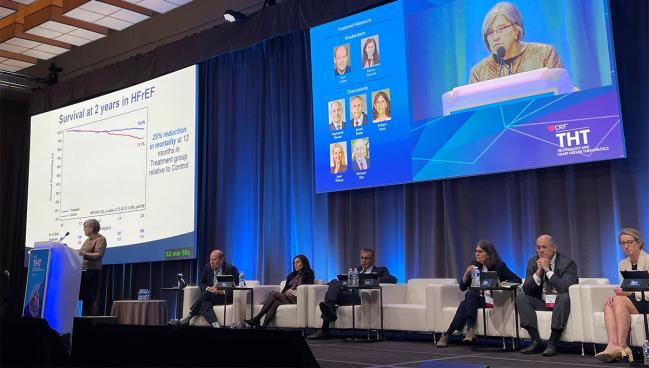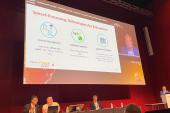Meta-analysis Hints at Survival Benefit With LAP Monitoring in HFrEF
Researchers in this space are also starting to ask: is it time to put patients in charge of tracking and acting on pressure changes?

A new meta-analysis combining patient-level mortality data from the CHAMPION, GUIDE-HF, and LAPTOP-HF trials is hinting that the relative mortality reduction at 2 years could be as big as 25% in monitored patients compared with controls, with differences only emerging after the 1-year mark.
JoAnn Lindenfeld, MD (Vanderbilt University Medical Center, Nashville, TN), who presented the analysis here at the Technology and Heart Failure Therapeutics (THT) 2023 meeting, acknowledged the shortcomings of the data but argued they offer an intriguing signal, one that makes the case for making sure novel approaches to pressure monitoring now under investigation continue beyond 12 months.
“This patient-level meta-analysis over 2 years of follow-up demonstrates that remote hemodynamic monitoring improves all-cause mortality and reduces HF hospitalizations in patients with HFrEF, with consistency observed across trials with different devices, different time periods, and evolving GDMT [guideline-directed medical therapy],” she said.
Speaking with TCTMD, Lindenfeld acknowledged that there will be “lots of discussion” about the findings, for a range of reasons. “I think this is an early step in saying, is there a mortality reduction? Which I think changes the importance of monitoring,” she said. Taking that further, it raises the question of whether diuretics, by lowering the wedge pressures, enhance survival.
“I think the answer to that is probably yes,” she told TCTMD.
There’s plenty to quibble with in the analysis. Both CHAMPION and GUIDE-HF were single-blinded studies of the CardioMEMS pulmonary artery pressure monitor, whereas LAPTOP-HF studied a direct left atrial pressure (LAP) monitoring system. LAPTOP-HF was stopped early due to an increase in adverse events, primarily related to complications with transseptal puncture back when the trial took place a decade ago, and full results have never been published. Treated patients, however, were followed for a median of 22 months, providing longer-term data for the current analysis. That’s much longer than patients in GUIDE-HF, with a median follow-up of just 8.2 months, meaning that there was very little data on outcomes beyond 12 months. Moreover, GUIDE-HF got derailed by the COVID-19 pandemic and missed its primary endpoint, although an analysis that censored the data according to COVID lockdowns (when patients were unable or reluctant to go to the hospital) demonstrated significant benefits of monitoring.
The LAPTOP device was never commercialized, but the CardioMEMS sensor was approved by the US Food and Drug Administration in 2014.
This meta-analysis, Lindenfeld noted, focuses only on patients with HFrEF, who made up the majority across the three studies. Of the 1,350 patients included in the meta-analysis, 700 had 1 year of follow-up and 273 had 2 or more years of follow-up.
In this group, said Lindenfeld, mortality patterns in all three trials appeared to follow a similar pattern, with no differences seen in the first 12 months, followed by a gradual separation of the curves. When patient-level data were combined, survival curves continued to diverge, such that by 24 months, overall mortality was 71.3% in patients randomized to standard management and 80.5% in those being actively monitored for pressure changes (HR 0.75; 95% CI: 0.57-0.98).
An analysis that included only GUIDE-HF patients enrolled and followed up prior to the COVID-19 lockdowns showed exactly the same results.
Looking Longer
Discussing the mortality curves following her presentation, Lindenfeld agreed that it might make sense for invasive monitoring-device trials such as the ones in her analysis, as well as newer, less-invasive approaches, to extend follow-up beyond 1 year.
As to why it takes a year before the curves start to separate, she told the panel: “You may have some arguments for this—someone will, I'm sure—but remember, we've known for a while that it takes ICDs about a year before you start to see a mortality benefit. Why is that? It takes a year because not everybody's ICD fires—it takes a while to accrue a number of patients whose lives have been saved by an ICD. And the same is true of hemodynamic monitoring—not everybody has an event right away. It takes a while to accrue patient, after patient, after patient event before you're going to be able to show a mortality benefit.”
That’s based on the assumption that medication changes are made in response to the changes detected on monitoring. While analyses have not yet been done for GUIDE-HF, she said, data from CHAMPION showed that medication changes happened twice as often in the monitoring arm as in the controls; most of the medication changes involved diuretics, but of those, half were to uptitrate and the others were dose reductions.
Another pressure-monitoring study, MONITOR-HF, will be unveiled at the upcoming European Society of Cardiology Heart Failure Congress and the hope is to be able to include patient-level survival data from that trial into an updated meta-analysis, she said. “To me, it's pretty exciting, and I think it [gives] us a whole different way of thinking about hemodynamic monitoring if we can get to a point where we can improve mortality in addition to just reducing hospitalizations.”
Empowering Patients
Another consideration will be who is best suited to act on the pressure signals. In a separate featured abstract presentation in the same THT session, William Abraham, MD (The Ohio State University Wexner Medical Center, Columbus), presented pilot study results from the VECTOR HF I and II studies looking at physician-directed patient self-management using information from the V-LAP implantable left atrial pressure sensor (Vectorious Medical Technologies).
While the trials of this device are still underway, this specific analysis of just 13 patients showed that they were much more likely to be compliant than physicians in terms of checking pressures and acting on them. They spent less time with persistent or very high left atrial pressures than did patients prior to the initiation of the self-management pilot, and they were capable of adjusting their diuretic doses based on the information provided by the LAP device. No patients were hospitalized over an average follow-up of 278 days.
“I think this data is really quite encouraging that this approach—putting knowledge of left atrial pressure into the patient's hands and having them self-adjust their medication on a day-to-day basis within physician-prescribed guidelines—can significantly reduce the risk of heart failure hospitalizations,” Abraham said. “In addition, this approach resulted in significant improvements in health status, including quality of life according to the KCCQ score, and significant improvements in the 6-minute hall walk distance. As well, you can see that, this approach allows most of the work to be done by the patient.”
Addressing the role of the patient following her presentation, Lindenfeld, too, said that having patients help with their own management would “ultimately” be the goal. First, she cautioned, “I think we have to show that that works. I trust them and I think that it will,” she said. “We just have to be aware that if we do it . . . we’re going to have to figure out how to do it correctly.”
Daniel Burkhoff, MD, PhD (Cardiovascular Research Foundation, New York, NY), commenting on the pressure-monitoring field for TCTMD, agreed. Having patients play a bigger role is “realistic,” he said. “It may not be for every single patient, but most patients moving forward are going to be much more comfortable with technology, with data, and with information coming to them [directly]. . . . A large majority of patients will be sophisticated enough to use this information if guided properly by their physicians.”
As for whether there will ever be conclusive data showing a mortality reduction with left atrial monitoring, Burkhoff said that time will tell. All of the data to date, he pointed out, is actually “good”—most of it comes from sham-controlled trials, with even the patients in LAPTOP-HF showing a benefit of monitoring, so long as their devices could be safely implanted.
And the significant reduction in rehospitalizations shouldn’t be minimized, Burkhoff argued, because it’s one of the most important endpoints for patients. “In every study that involved patient assessments that asked, ‘What’s important to you?’, patients want to have better quality of life and better exercise tolerance,” he said. “They want to stay out of hospital, but while they’re out of hospital they want a better quality of life.”
Shelley Wood was the Editor-in-Chief of TCTMD and the Editorial Director at the Cardiovascular Research Foundation (CRF) from October 2015…
Read Full BioSources
Lindenfeld J. Longer term effects of hemodynamic monitoring on outcomes: a combined data analysis of patients with HFrEF in CHAMPION, GUIDE-HF, and LAPTOP-HF. Presented at: THT 2023. March 21, 2023. Boston, MA.
Disclosures
- Abraham reports consulting fees/honoraria from Vectorious Medical Technologies.
- Burkhoff reports grants/research contracts from Abiomed, Ancora, and Zoll; consulting/honoraria/speakers bureau payments from Corvia, BackBeat, Medical, Impulse Dynamics, BioMind, Zoll, Therox, and Aquapass; and equity/stock options from PVLoops.
- Lindenfeld reports consulting/honoraria/speakers bureau payments from Abbott Vascular, AstraZeneca, Edwards Lifesciences, Boston Scientific, Biotronik, Medtronic, Merck/Schering Plough, and St. Jude Medical, as well as grant support/research contracts from AstraZeneca.





Comments